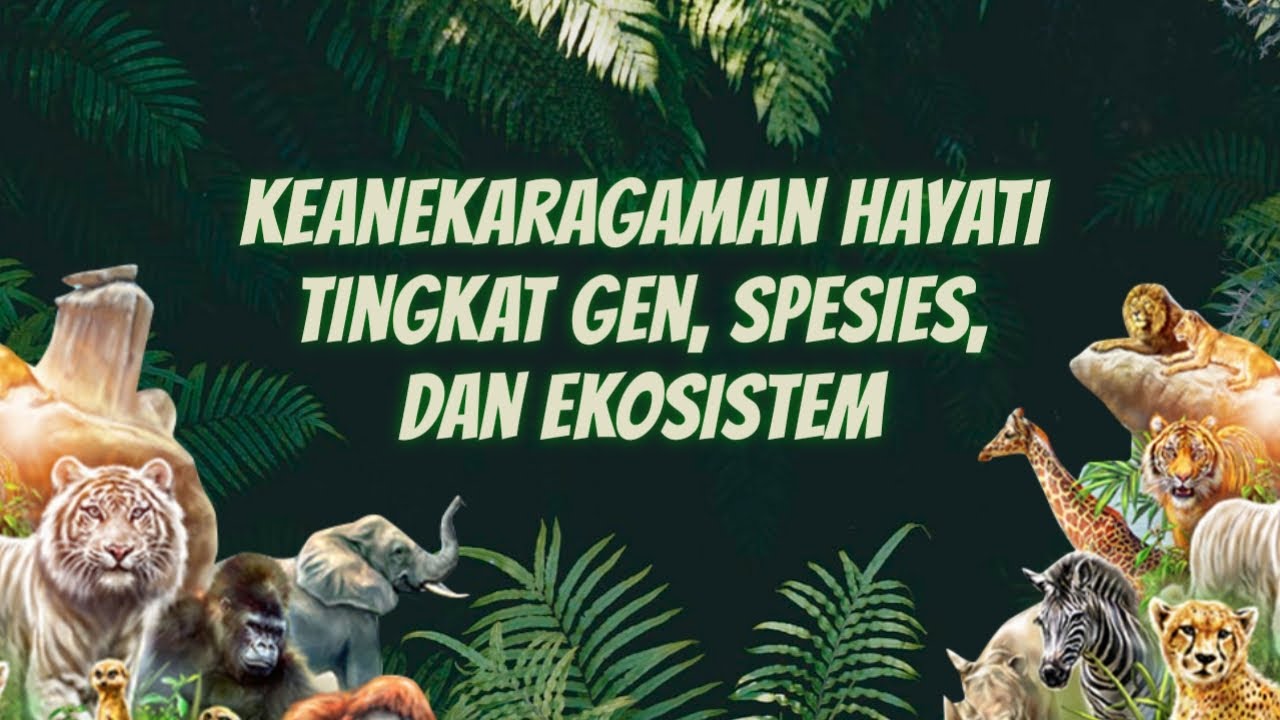KEANEKARAGAMAN MAHLUK HIDUP DAN KLASIFIKASI : BIOLOGI KELAS 10 SMA
Summary
TLDRThis educational video script delves into the concept of biodiversity, discussing its three main levels: genetic, species, and ecosystem diversity. It provides examples such as mango varieties and rice types to illustrate genetic diversity, and uses palms and beans to demonstrate species diversity within the same family. The script further explains ecosystem diversity through the adaptation of plants like coconut and bakau trees. It also highlights Indonesia's rich biodiversity due to its tropical climate and geographical location, emphasizing the importance of conservation for ecological balance. The video concludes with an overview of biological classification, from natural to phylogenetic systems, and the historical development of classification systems, including the five-kingdom classification.
Takeaways
- 🌿 The script discusses the concept of biodiversity, which includes the variety of forms, numbers, and characteristics found in living organisms.
- 🔬 Biodiversity can be categorized into three levels: genetic diversity, species diversity, and ecosystem diversity.
- 🍎 Genetic diversity refers to the variation in genes among individuals within the same species, such as different varieties of mangoes.
- 🌱 Species diversity is the variety among different species within the same genus or family, like coconuts and kinang in the Arecaceae family.
- 🏞 Ecosystem diversity is represented by the variety of ecosystems where different species interact with each other and their environment, forming unique life systems.
- 📍 Indonesia is highlighted as a country with high biodiversity due to its tropical climate and location along the equator.
- 🌳 The distribution of flora and fauna in Indonesia is divided based on the Wallace and Weber lines, creating different faunal types such as Asiatic, transitional, and Australasian.
- 🌼 Indonesia's flora is also divided into three types: Asiatic, transitional, and Australasian, with examples like mangroves, ebony, and eucalyptus.
- 🌿 The importance of preserving biodiversity is emphasized as its reduction can lead to ecosystem imbalance and environmental damage.
- 🔬 Classification or taxonomy is introduced as a way to categorize living organisms into smaller groups for easier study and understanding of their relationships.
- 📚 The script covers three types of classification systems: natural, artificial, and phylogenetic, each with its basis and examples.
- 🏛 The hierarchy of biological classification from kingdom to species is explained, with the number of shared characteristics and individuals varying across these levels.
Q & A
What is the main topic discussed in the video?
-The main topic discussed in the video is the diversity of living organisms, their classification, and the importance of biodiversity in Indonesia.
What are the three levels of biodiversity mentioned in the script?
-The three levels of biodiversity mentioned are genetic diversity, species diversity, and ecosystem diversity.
Can you provide an example of genetic diversity given in the script?
-An example of genetic diversity given in the script is the different varieties of mangoes, such as 'manalagi', 'golek', 'harum', and 'manis', which all belong to the species 'Mangifera indica'.
What is the purpose of classifying living organisms?
-The purpose of classifying living organisms is to facilitate the study of the vast variety of life forms, understand the relationships between different organisms, and to learn about their evolution and development.
What are the three types of classification systems discussed in the video?
-The three types of classification systems discussed are natural classification, artificial classification, and phylogenetic classification.
What is the basis for the natural classification system?
-The basis for the natural classification system is the similarity of characteristics, especially morphological or structural body parts.
How many kingdoms were initially proposed by Carolus Linnaeus in his classification system?
-Carolus Linnaeus initially proposed two kingdoms in his classification system: 'Vegetabilia' for plants and 'Animalia' for animals.
What is the significance of the 'Wallace Line' and 'Weber Line' in the context of Indonesia's biodiversity?
-The 'Wallace Line' and 'Weber Line' are imaginary lines that divide Indonesia into different regions based on the distribution of flora and fauna, which helps to understand the unique biodiversity of the country.
What are the three types of fauna found in Indonesia according to the script?
-The three types of fauna found in Indonesia are Asian fauna in the West, transitional fauna in the middle with many endemic animals, and Australasian fauna in the East.
What is the difference between 'Plantae' and 'Animalia' kingdoms?
-The main difference between the 'Plantae' and 'Animalia' kingdoms is that 'Plantae' are autotrophic and can produce their own food through photosynthesis, while 'Animalia' are heterotrophic and cannot produce their own food.
What is the importance of understanding biodiversity in Indonesia?
-Understanding biodiversity in Indonesia is important because it helps to maintain the balance of ecosystems and prevents environmental damage caused by the loss of biodiversity.
Outlines

このセクションは有料ユーザー限定です。 アクセスするには、アップグレードをお願いします。
今すぐアップグレードMindmap

このセクションは有料ユーザー限定です。 アクセスするには、アップグレードをお願いします。
今すぐアップグレードKeywords

このセクションは有料ユーザー限定です。 アクセスするには、アップグレードをお願いします。
今すぐアップグレードHighlights

このセクションは有料ユーザー限定です。 アクセスするには、アップグレードをお願いします。
今すぐアップグレードTranscripts

このセクションは有料ユーザー限定です。 アクセスするには、アップグレードをお願いします。
今すぐアップグレード5.0 / 5 (0 votes)






